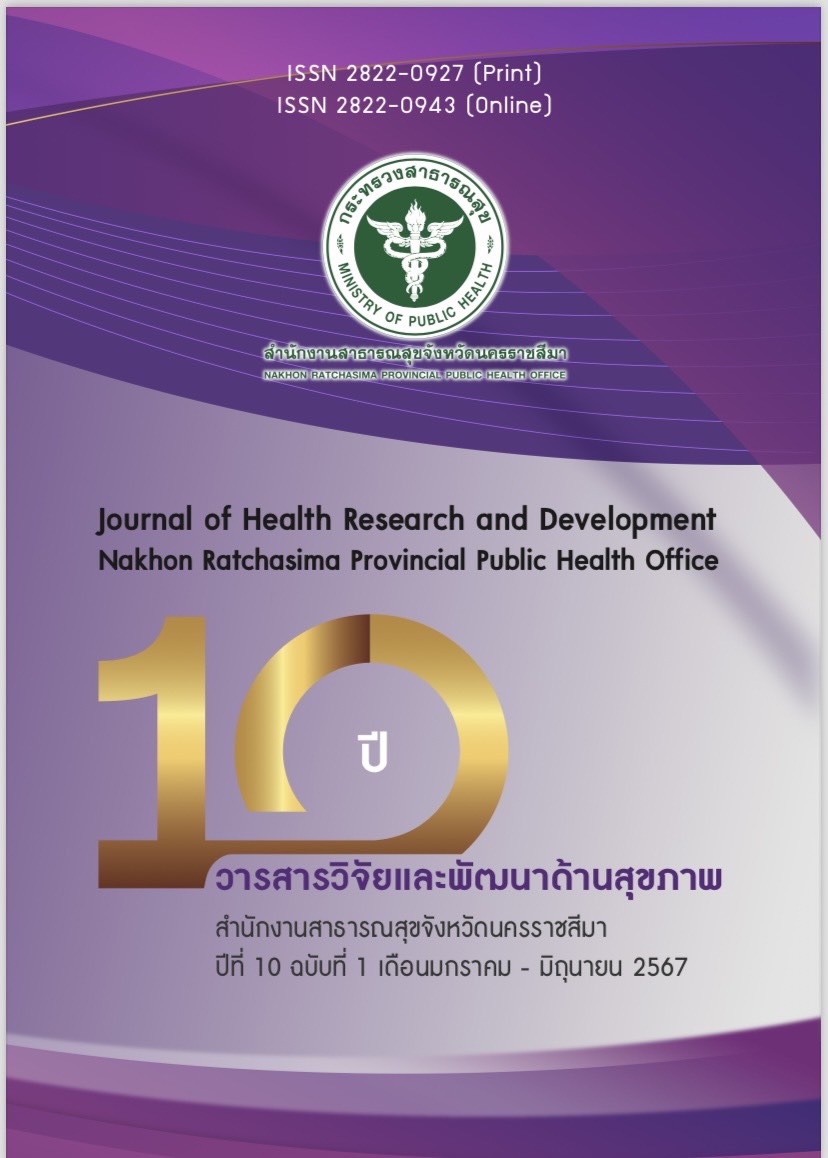ปัจจัยที่มีผลต่อภาวะขาดออกซิเจนของทารกแรกเกิดในโรงพยาบาลมหาวิทยาลัยเทคโนโลยีสุรนารี
คำสำคัญ:
ภาวะขาดออกซิเจนของทารกแรกเกิด, คะแนน APGAR , โรงพยาบาลมหาวิทยาลัย, ปัจจัยบทคัดย่อ
ภาวะขาดออกซิเจนของทารกแรกเกิดเป็นปัญหาทางการแพทย์และสาธารณสุขที่ร้ายแรงทั่วโลก รวมถึงประเทศไทยด้วย ซึ่งมีผลอย่างมากต่อการเจ็บป่วยและเสียชีวิตของทารกแรกเกิด ภาวะขาดออกซิเจนในทารกแรกเกิดมีสาเหตุจากปัจจัยทางด้านมารดา ทารก และกระบวนการคลอดบุตร การวิจัยนี้มีวัตถุประสงค์เพื่อศึกษาปัจจัยด้านมารดา ทารก บริการสุขภาพ และสิ่งแวดล้อมที่มีผลต่อการเกิดภาวะขาดออกซิเจนของทารกแรกเกิด การวิจัยนี้เป็น Retrospective study ที่โรงพยาบาลมหาวิทยาลัยเทคโนโลยีสุรนารี เก็บข้อมูลจากเวชระเบียนของสตรีที่มาคลอดบุตร ปี พ.ศ. 2563 - 2565 รวบรวมข้อมูลปัจจัยด้านมารดา ทารก บริการสุขภาพ และสิ่งแวดล้อม นำข้อมูลมาวิเคราะห์ด้วยสถิติเชิงพรรณนา ได้แก่ ร้อยละ ค่าเฉลี่ย+ส่วนเบี่ยงเบนมาตรฐาน และ independent T-test
ผลการวิจัย พบว่า สตรีที่มาคลอดบุตร จำนวน 276 คน เปรียบเทียบกลุ่มสตรีคลอดบุตรที่มีภาวะขาดออกซิเจนของทารกแรกเกิดและไม่มีภาวะขาดออกซิเจนของทารกแรกเกิด พบว่าอายุครรภ์ < 37 สัปดาห์ ร้อยละ 18.1 และ ร้อยละ 10.1 ตามลำดับ มีความแตกต่างกันอย่างมีนัยสำคัญทางสถิติ (p = 0.039) สตรีคลอดบุตรที่มีภาวะขาดออกซิเจนของทารกแรกเกิดมีความดันโลหิตสูง ร้อยละ 11.6 มากกว่าสตรีคลอดบุตรที่ไม่มีภาวะขาดออกซิเจนของทารกแรกเกิด ร้อยละ 6.4 มีความแตกต่างกันอย่างมีนัยสำคัญทางสถิติ (p = 0.043) ส่วนนำทารกเป็นศีรษะ พบร้อยละ 88.2 และ ร้อยละ 89.9 มีความแตกต่างกันอย่างมีนัยสำคัญทางสถิติ (p = 0.001) การเสียเลือดตอนคลอด 395.00 ± 299.30 และ 321.52 ± 233.61 ซีซี (p = 0.024) และวิธีการคลอดด้วยการดูดสุญญากาศและการผ่าตัดคลอดร้อยละ 71.0 และร้อยละ 51.1 (p = 0.001) สรุปว่า อายุครรภ์ ความดันโลหิตสูงของมารดา ส่วนนำของทารกการเสียเลือดตอนคลอด และวิธีการคลอด ที่ต่างกัน ก่อให้เกิดการเกิดภาวะขาดออกซิเจนของทารกแรกเกิดที่ต่างกัน
เอกสารอ้างอิง
Berhe YZ, Kebedom AG, Gebregziabher L, et al. Risk factors of birth asphyxia among neonates born in public hospitals of Tigray, Northern Ethiopia. Pediatric Health Med Ther. 2020; 11: 13-20.
Vogel JP, Souza JP, Mori R, et al; WHO Multicountry Survey on Maternal and Newborn Health Research Network. Maternal complications and perinatal mortality: findings of the World Health Organization Multicountry Survey on Maternal and Newborn Health. BJOG. 2014 Mar;121 Suppl 1:76 – 88.
Collins KA, Popek E. Birth injury: birth asphyxia and birth trauma. Acad Forensic Pathol. 2018; 8: 788 – 64.
Akangire G, Carter B. Birth Injuries in Neonates. Pediatr Rev. 2016 Nov; 37(11): 451 – 62.
Rattanaprom P, Ratinthorn A, Sindhu S, et al. Contributing factors of birth asphyxia in Thailand: a case-control study. BMC Pregnancy Childbirth. 2023 Aug 15; 23(1): 584.
Ministry of Public Health (Thailand), Department of Health. Birth Asphyxia Rate 2021. Department of Health Dashboard. 2021. Available from: https://dashboard.anamai.moph.go.th /dashboard/birthasphyxia/index?year=2021.
Michel A. Review of the Reliability and Validity of the Apgar Score. Adv Neonatal Care. 2022 Feb 1;22(1):28 – 34.
Strategy and Planning Division. Health Statistic 2017. Strategy and Planning Division, Ministry of Public Health, Thailand. 2018. Available from: https://bps.moph.g.th/new_bps/ sites/ default/files/stratistics60.pdf.
Executive summary: Neonatal encephalopathy and neurologic outcome, second edition. Report of the American College of Obstetricians and Gynecologists' Task Force on Neonatal Encephalopathy. Obstet Gynecol 2014; 123(4): 896 – 901.
Fares K, Mehdi HA, Imad BM. Correlation between Umbilical Cord pH, Apgar Score and Pregnancy Outcome in High-Risk Pregnancy. 2019; 7(2): 5.
AMERICAN ACADEMY OF PEDIATRICS COMMITTEE ON FETUS AND NEWBORN; AMERICAN COLLEGE OF OBSTETRICIANS AND GYNECOLOGISTS COMMITTEE ON OBSTETRIC PRACTICE. The Apgar Score. Pediatrics 2015 ;136(4): 819 – 22.
Hagag AA, El Frargy MS, Abd El-Latif AE. Study of Cord Blood Erythropoietin, Leptin and Adiponectin Levels in Neonates with Hypoxic Ischemic Encephalopathy. Endocr Metab Immune Disord Drug Targets 2020; 20(2):213 – 20 .
Pathak V, Sahu DS. Relation between immediate postpartum APGAR score with umblical cord blood pH and fetal distress. Int J Reprod Contracept Obstet Gynecol. 2019 Dec;8(12):4690-4.
Ali I, Batta RI, Yaseen RM, et al. Antenatal corticosteroids and fetal lung immaturity in preterm birth. Heliyon. 2020 Jun 18; 6(6): 4116.
Bayih WA, Birhane BM, Belay DM, et al. The state of birth asphyxia in Ethiopia: An umbrella review of systematic review and meta-analysis reports 2020; 7(10): 08128.
Downes KL, Grantz KL, Shenassa ED. Maternal, Labor, Delivery, and Perinatal Outcomes Associated with Placental Abruption: A Systematic Review 2017; 34(10): 935 - 57.
Ghimire B, Pathak P, Gachhadar R, et al. Immediate Fetal Outcome in Deliveries with Meconium Stained Amniotic Fluid. J Nepal Health Res Counc 2022; 19(4): 681-7.
Tu JH, Profit J, Melsop K, et al. Relationship of hospital staff coverage and delivery room resuscitation practices to birth asphyxia. Am J Perinatol 2017; 07(03): 259 – 63.
Morioka N, Tomio J, Seto T, et al. The association between higher nurse staffing standards in the fee schedules and the geographic distribution of hospital nurses: A cross-sectional study using nationwide administrative data. BMC Nursing 2017; 16 : 25.
Liu X, Zheng J, Liu K, et al. Hospital nursing organisational factors, nursing care left undone, and nurse burnout as predictors of patient safety: A structural equation modeling analysis. Int. J. Nurs. Stud. 2018; 86: 82 – 9.
Amiri A, Vehviläinen-Julkunen K, Solankallio-Vahteri T, et al. Impact of nurse staffing on reducing infant, neonatal and perinatal mortality rates: Evidence from panel data analysis in 35 OECD countries. Int J Nurs. Sci. 2020; 7(2): 161-9.
Stimpfel AW, Aiken LH. Hospital staff nurses' shift length associated with safety and quality of care. J Nurs Care Qual 2013; 28(2): 122-9.
Sharma S, Rani R. Nurse-to-patient ratio and nurse staffing norms for hospitals in India: A critical analysis of national benchmarks. J Family Med Prim. Care. 2020; 9(6): 2631 – 7.
Mildenberger C, Ellis C, Lee K. Neonatal resuscitation training for midwives in Uganda: Strengthening skill and knowledge retention. Midwifery. 2017; 50: 36 – 41.
Ljungblad LW, Sandvik SO, Lyberg A. The impact of skilled birth attendants trained on newborn resuscitation in Tanzania: A literature review. Int J Afr Nurs Sci. 2019; 11: 100168.
ดาวน์โหลด
เผยแพร่แล้ว
รูปแบบการอ้างอิง
ฉบับ
ประเภทบทความ
สัญญาอนุญาต
ลิขสิทธิ์ (c) 2024 สำนักงานสาธารณสุขจังหวัดนครราชสีมา

อนุญาตภายใต้เงื่อนไข Creative Commons Attribution-NonCommercial-NoDerivatives 4.0 International License.
บทความที่ได้รับการตีพิมพ์เป็นลิขสิทธิ์ของสำนักงานสาธารณสุขจังหวัดนครราชสีมา กระทรวงสาธารณสุข
ข้อความที่ปรากฏในบทความแต่ละเรื่องในวารสารวิชาการเล่มนี้เป็นความคิดเห็นส่วนตัวของผู้เขียนแต่ละท่านไม่เกี่ยวข้องกับสำนักงานสาธารณสุขจังหวัดนครราชสีมา และบุคลากรท่านอื่นๆในสำนักงานฯ แต่อย่างใด ความรับผิดชอบองค์ประกอบทั้งหมดของบทความแต่ละเรื่องเป็นของผู้เขียนแต่ละท่าน หากมีความผิดพลาดใดๆ ผู้เขียนแต่ละท่านจะรับผิดชอบบทความของตนเองแต่ผู้เดียว



